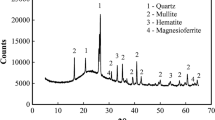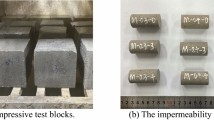Abstract
The reaction and microstructure of the cement–fly-ash system were investigated in the present study. The reaction of cement–fly-ash system was described by a diffusion-controlled reaction process, leaving aside the nucleation and growth and boundary phase reaction processes at an earlier stage. The extent of hydration and the microstructure of hydrates were investigated by employing thermogravimetry, nitrogen adsorption/desorption analysis and scanning electron microscopy. A descriptive model of the reaction processes of the cement–fly-ash system was proposed to determine the importance of each process. In summary, (a) the blending of fly ash augments the local water-to-cement ratio and affects the heterogeneous nucleation of hydrates, promoting the hydration rate and extent; (b) the rapid hydration of cement coats the fly ash, retarding the dissolution and reaction of fly ash; (c) the continual dissolution of active silica-aluminate etches the surface of fly ash; and (d) the diffusion coefficient is estimated as 10−19 m2/s.










Similar content being viewed by others
Abbreviations
- b :
-
Binder mass (kg/m3)
- c :
-
Cement mass (kg/m3)
- f b :
-
Mass fraction of blend material (kg/kg)
- f C :
-
Mass fraction of cement (kg/kg)
- f FA :
-
Mass fraction of fly ash (kg/kg)
- h c :
-
Constant (m2/kg)
- h t :
-
Time-dependent parameter
- k A :
-
Efficient factor
- k d :
-
Diffusion coefficient (m2/s)
- \(\Updelta m_{{\rm Wn}}\) :
-
Mass loss of non-evaporable water (g/g)
- \(\Updelta m_{{\rm CH}}\) :
-
Mass loss of calcium hydroxide (g/g)
- t :
-
Reaction time (s or day)
- t 0 :
-
Time for the diffusion-controlled reaction (s or day)
- t I–D :
-
Time for the reaction transition (s or day)
- w :
-
Water mass (kg/m3)
- C :
-
Reaction constant by nucleation and growth processes
- CH:
-
Calcium hydroxide (g/g)
- \(\hbox{CH}_{(\infty,\hbox{C})}\) :
-
Calcium hydroxide by cement with complete reaction (g/g)
- \(\hbox{CH}_{(\infty,\hbox{FA})}\) :
-
Calcium hydroxide by fly ash with complete reaction (g/g)
- K D :
-
Rate coefficient of diffusion process (1/s)
- LOI:
-
Ignition loss (g/g)
- LOIC :
-
Ignition loss of cement (g/g)
- LOIFA :
-
Ignition loss of fly ash (g/g)
- R :
-
Radius of cementitious particles (m or μm)
- S b :
-
Specific surface area of blend material (m2/kg)
- S eff :
-
Effective specific surface area (m2/kg)
- Wn:
-
Non-evaporable water (g/g)
- \(\hbox{Wn}_{(\infty,\hbox{C})}\) :
-
Non-evaporable water by cement with complete reaction (g/g)
- \(\hbox{Wn}_{(\infty,\hbox{FA})}\) :
-
Non-evaporable water by fly ash with complete reaction (g/g)
- α :
-
Reaction extent (–)
- α′:
-
Reaction extent of neat cement (–)
- α C :
-
Reaction extent of cement (–)
- α FA :
-
Reaction extent of fly ash (–)
- \(\Updelta\alpha_{\rm HN}\) :
-
Reaction extent changes by the heterogeneous nucleation (–)
- \(\epsilon\) :
-
Efficacy function (–)
References
Ben Haha M, De Weerdt K, Lothenbach B (2010) Quantification of the degree of reaction of fly ash. Cem Concr Res 40:1620–1629
Papadakis VJ (1999) Effect of fly ash on Portland cement systems. Part I: Low-calcium fly ash. Cem Concr Res 29:1727–1736
Lam L, Wong YL, Poon CS (2000) Degree of hydration and gel/space ratio of high-volume fly ash/cement systems. Cem Concr Res 30:747–756
Fernandez-Jimenez A, Palomo A (2005) Composition and microstructure of alkali activated fly ash binder: effect of the activator. Cem Concr Res 35:1984–1992
Fernandez-Jimenez A, Palomo A, Criado M (2005) Microstructure development of alkali-activated fly ash cement: a descriptive model. Cem Concr Res 35:1204–1209
Pacheco-Torgal F, Castro-Gomes J, Jalali S (2008) Alkali-activated binders: a review. Part Charact 1. Historical background, terminology, reaction mechanisms and hydration products. Constr Build Mater 22:1305–1314
Duxson P, Provis JL, Lukey GC, van Deventer JSJ (2007) The role of inorganic polymer technology in the development of ‘green concrete’. Cem Concr Res 37:1590–1597
Duxson P, Fernandez-Jimenez A, Provis JL, Lukey GC, Palomo A, van Deventer JSJ (2007) Geopolymer technology: the current state of the art. J Mater Sci 42:2917–2933
Li L, Zhao N, Wei W, Sun Y (2013) A review of research progress on CO2 capture, storage, and utilization in Chinese Academy of Sciences. Fuel Cells 108:112–130
Kumar R, Kumar S, Mehrotra SP (2007) Towards sustainable solutions for fly ash through mechanical activation. Resour Conserv Recycl 52:157–179
Back M, Kuehn M, Stanjek H, Stefan P (2008) Reactivity of alkaline lignite fly ashes towards CO2 in water. Environ Sci Technol 42(12):4520–4526
Provis JL, Lukey GC, van Deventer JSJ (2005) Do geopolymers actually contain nanocrystalline zeolites? A reexamination of existing results. Chem Mater 17:3075–3085
Skvara F, Kopecky L, Smilauer V, Bittnar Z (2009) Material and structural characterization of alkali activated low-calcium brown coal fly ash. J Hazard Mater 168:711–720
Ma Y, Hu J, Ye G (2013) The pore structure and permeability of alkali activated fly ash. Fuel Cells 104:771–780
Sindhunata, van Deventer JSJ, Lukey GC, Xu H (2006) Effect of curing temperature and silicate concentration on fly-ash-based geopolymerization. Ind Eng Chem Res 45:3559–3568
Fernandez-Jimenez A, de la Torre AG. Palomo A, Lopez-Olmo G, Alonso MM, Aranda MAG (2006) Quantitative determination of phases in the alkaline activation of fly ash. Part II: Degree of reaction. Fuel 85:1960–1969
Lawrence P, Cyr M, Ringot E (2003) Mineral admixtures in mortars: effect of inert materials on short-term hydration. Cem Concr Res 33:1939–1947
Cyr M, Lawrence P, Ringot E (2005) Mineral admixtures in mortars: quantification of the physical effects of inert materials on short-term hydration. Cem Concr Res 35:719–730
Zeng Q, Li K, Fen-Chong T, Dangla P (2012) Determination of cement hydration and pozzolanic reaction extents for fly-ash cement pastes. Constr Build Mater 27:560–569
Hanehara S, Tomosawa F, Kobayakawaa M, Hwang K (2001) Effects of water/powder ratio, mixing ratio of fly ash, and curing temperature on pozzolanic reaction of fly ash in cement paste. Cem Concr Res 31:31–39
Kovalchuk G, Fernandez-Jimenez A, Palomo A (2007) Alkali-activated fly ash: effect of thermal curing conditions on mechanical and microstructural development—part II. Fuel Cells 86:315–322
Dabic P, Krstulovic R, Rusic D (2000) A new approach in mathematical modelling of cement hydration development. Cem Concr Res 30:1017–1021
Krstulovic R, Dabic P (2000) A conceptual model of the cement hydration process. Cem Concr Res 30:693–698
Thomas JJ (2007) A new approach to modeling the nucleation and growth kinetics of tricalcium silicate hydration. J Am Ceram Soc 90(10):3282–3288
Cahn JW (1956) The kinetics of grain boundary nucleated reactions. Acta Metall Mater 4:449–459
Thomas JJ, Jennings HM, Chen JJ (2000) Influence of nucleation seeding on the hydration mechanisms of tricalcium silicate and cement. J Phys Chem C 113:4327–4334
Bishnoi S, Scrivener KL (2009) Studying nucleation and growth kinetics of alite hydration using μic. Cem Concr Res 39:849–860
Bishnoi S (2008) Vector modelling of hydrating cement microstructure and kinetics. École Polytechnique Fédérale de Lausanne, Suisse
Scherer GW, Zhang J, Thomas JJ (2012) Nucleation and growth models for hydration of cement. Cem Concr Res 42:982–983
Scherer GW (2012) Models of confined growth. Cem Concr Res 42:1252–1260
Kirby DM, Biernacki JJ (2012) The effect of water-to-cement ratio on the hydration kinetics of tricalcium silicate cements: testing the two-step hydration hypothesis. Cem Concr Res 42:1147–1156
Biernacki JJ, Xie T (2011) An advanced single particle model for C3S and alite hydration. J Am Ceram Soc 94(7):2037–2047
Baert G (2009) Physico-chemical interaction in Portland cement-(high volume) fly ash binders. Ph.D. thesis, Department of Structural Engineering, Ghent University, Belgium
Wang XY, Cho HK, Lee HS (2011) Prediction of temperature distribution in concrete incorporating fly ash or slag using a hydration model. Composites B 42:27–40
Wang XY, Lee HS (2010) Modeling the hydration of concrete incorporating fly ash or slag. Cem Concr Res 40:984–996
Scrivener KL, Nonat A (2011) Hydration of cementitious materials. present and future. Cem Concr Res 41:651–665
Chen C, Gong WL, Lutze W, Pegg IL (2011) Kinetics of fly ash geopolymerization. J Mater Sci 46:3073–3083
Wong HS, Buenfeld NR (2009) Determining the water–cement ratio, cement content, water content and degree of hydration of hardened cement paste: Method development and validation on paste samples. Cem Concr Res 39:957–965
Tang CW (2010) Hydration properties of cement pastes containing high-volume mineral mixtures. Comput Concr 7:17–38
Jennings HM (2008) Refinements to colloid model of C–S–H in cement: CM-II. Cem Concr Res 38:275–289
Babu KG, Rao GSN (1996) Efficiency of fly ash on concrete with age. Cem Concr Res 26:465–474
Bijen J, van Selst R (1993) Cement equivalence factors for fly ash. Cem Concr Res 23:1029–1039
Oey T, Kumar A, Bullard JW, Narayanan N, Sant G (2013) The filler effect: the influence of filler content and surface area on cementitous reaction rates. J Am Ceram Soc 96:1978–1990
Zeng Q, Li K, Fen-Chong T, Dangla P (2012) Pore structure characterization of cement pastes blended with high-volume fly-ash. Cem Concr Res 42:194–204
Zeng Q, Li K, Fen-Chong T, Dangla P (2012) Analysis of pore structure, contact angle and pore entrapment of blended cement pastes from mercury porosimetry data. Cem Concr Compos 34:1053–1060
Aligizaki KK (2006) Pore structure of cement-based materials—testing, Interpretation and requirement. Taylor & Francis, New York
Zeng Q, Li K, Fen-Chong T, Dangla P (2013) Water removal by freeze-drying of hardened cement paste. Dry Technol 31:67–71
Marsh BK, Day RL (1988) Pozzolanic and cementitious reactions of fly ash blended cement pastes. Cem Concr Res 18:301–310
Pane I, Hansen W (2005) Investigation of blended cement hydration by isothermal calorimetry and thermal analysis. Cem Concr Res 35:1155–1164
Berliner R, Popovici M, Herwig KW, Berliner M, Jennings HM, Thomas JJ (1998) Quasielastic neutron scattering study of the effect of water to cement ratio on the hydration kinetics of tricalcium silicate. Cem Concr Res 28(2):231–243
Bullard JW (2008) A determination of hydration mechanisms for tricalcium silicate using a kinetic cellular automaton model. J Am Ceram Soc 91(7):2088–2097
Evans JW, De Jonghe LC (1991) The production of inorganic materials. Macmillan, New York
Juilland P, Gallucci E, Flatt R, Scrivener K (2010) Dissolution theory applied to the induction period in alite hydration. Cem Concr Res 40:831–844
Nicoleau N, Nonat A, Perrey D (2013) The di- and tricalcium silicate dissolutions. Cem Concr Res 47:14–30
Gallucci E, Mathur P, Scrivener K (2010) Microstructural development of early age hydration shells around cement grains. Cem Concr Res 40:4–13
Kumar A, Bishnoi S, Scrivener KL (2010) Modelling early age hydration kinetics of alite. Cem Concr Res 42:903–918
Remond S, Bentz DP, Pimienta P (2002) Effects of the incorporation of municipal solid waste incineration fly ash in cement pastes and mortars. Part 2: modeling. Cem Concr Res 32(4):565–576
Girao AV, Richardson IG, Taylor R, Brydson RMD (2010) Composition, morphology and nanostructure of C–S–H in 70 % white Portland cement-30 % fly ash blends hydrated at 55 °C. Cem Concr Res 40(9):1350–1359
Acknowledgments
The research is supported by general financial grant from the China Postdoctoral Science Foundation (No. 2012M520288) and China national major fundamental research grant (973 Program, No. 2009CB623106).
Author information
Authors and Affiliations
Corresponding author
Rights and permissions
About this article
Cite this article
Zeng, Q., Li, K. Reaction and microstructure of cement–fly-ash system. Mater Struct 48, 1703–1716 (2015). https://doi.org/10.1617/s11527-014-0266-y
Received:
Accepted:
Published:
Issue Date:
DOI: https://doi.org/10.1617/s11527-014-0266-y




